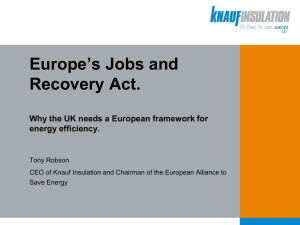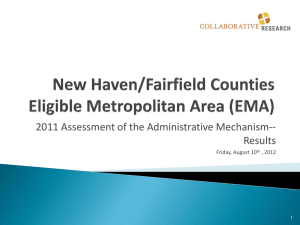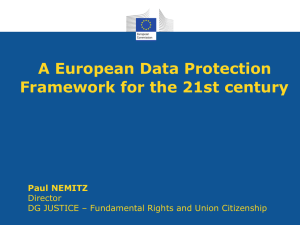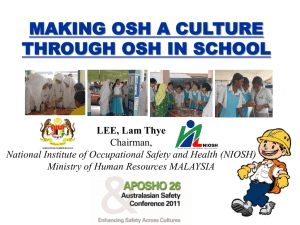Ex-post evaluation OSH
advertisement
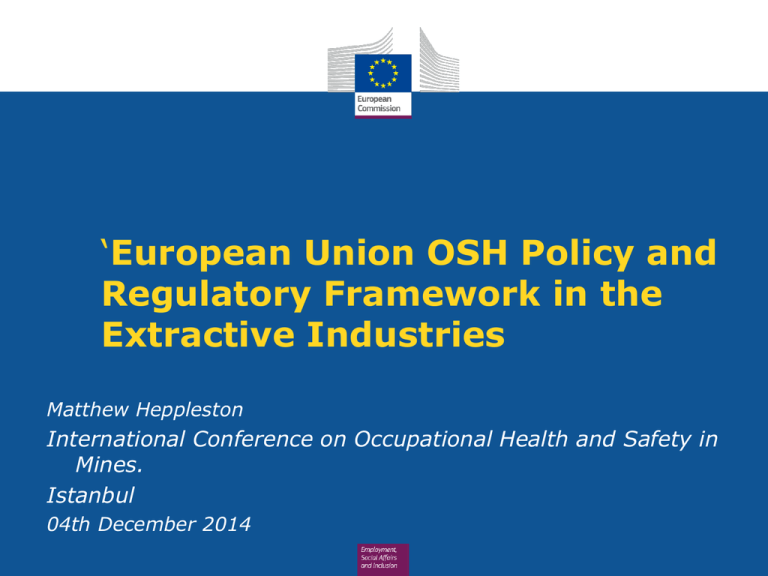
‘European Union OSH Policy and Regulatory Framework in the Extractive Industries Matthew Heppleston International Conference on Occupational Health and Safety in Mines. Istanbul 04th December 2014 Structure of the presentation • • • • Strategic Framework 2014-2020 Ex post evaluation OSH in the Extractive Industries Conclusion 2 The EU Strategic Framework on Health and Safety at Work 2014-2020 • Format is a Communication from the Commission • Published in Brussels 6.6.2014 • Number COM(2014) 332 final (Use your favourite web search engine) 3 What are the main challenges? • A stocktake of the previous strategy shows key challenges are common across the European union and require further policy action. • Three major challenges identified: 1. 2. 3. Implementation in Member States Aging workforce, emerging or new risks, prevention of occupational diseases Tackling demographic change 4 First challenge : How to improve the implementation record in MS? • The scope and effectiveness of OSH management remains a challenge for micro and SMEs. Show lower levels of compliance with rules. • Effective protection of workers’ health and safety has to be ensured in all workplaces regardless of size. • Simpler, more efficient solutions that take into account the situation of micro and small enterprises: • simplifying legislation where appropriate, and • providing tailored guidance and support to micro and small enterprises to facilitate risk assessment. 5 How can we facilitate compliance with OSH legislation, particularly by micro and small enterprises • Risk is not related to the size of the undertaking: • Small enterprises may have high risk activities e.g. foundries, machine shops, construction work etc. • Risk relates to the activity being performed and is also a dynamic process which needs to be kept under ongoing review: • Need to help SME to better understand their obligations of risk assessment (i.e. it is not the end point) and how it is used in a process which leads onto effective risk control. 6 Second challenge: aging workforce, emerging or new risks, prevention of occupational diseases • Issues with stress, ergonomic risks and moving loads as well as anxiety and depression are by far the most often mentioned health problems caused or worsened by work (Euro Barometer survey 2014). • Industrial application of new technologies and new work organization, despite their obvious benefits, can entail risks (e.g. nano, bio and green technologies)it is necessary to gather and evaluate sound scientific evidence, to identify how emerging new risks can best be addressed. 7 Second challenge: aging workforce, emerging or new risks, prevention of occupational diseases.(continued) • Identify ways to promote the physical and psychological health of older workers. • Changes in work organisation through IT developments could allow more flexible and interactive working. • Raise awareness of: psychosocial and mental health disorders, occupational cancers, lung diseases, skin diseases, asthma and other chronic conditions, ergonomics and musculoskeletal disorders. • The assessment of new emerging risks. • Based on scientific evidence, the results will be crucial parts of the ex post evaluation of current OSH legislation. 8 Third challenge: Tackling demographic change • The EU population is becoming older and the working population is • • • also ageing. In order to ensure sustainable social security, an extension of working life is necessary. This will require appropriate working conditions throughout the entire working life. Successfully prolonging working careers depends on appropriate adaptation of workplaces and work organisation, including working time, workplace accessibility and workplace interventions targeted at older workers. Reintegration and rehabilitation measures allowing for early return to work after an accident or disease are needed to avoid early exclusion from the labour market. 9 Key Strategic Objectives: • Actions will be implemented or developed in close collaboration with member States, social partners and other stakeholders. • Progress in delivering the action plan will be the subject of systematic monitoring and evaluation. • Results will feed into the evaluation of OSH legislation. • 7 key tasks 10 Key Strategic Objectives: 7 key tasks 1. Further consolidate national strategies 2.Facilitate compliance 3. Better enforcement in Member States 4. Simplify existing legislation 5. Aging workforce, new risks, diseases 6. Improve statistical data 7. Coordinate EU and international efforts 11 • • • • Strategic Framework 2014-2020 Ex post evaluation OSH in the Extractive Industries Conclusion 12 Ex-post evaluation OSH - general • New five-yearly exercise under Framework Directive 89/391/EEC. the OSH • First exercise covering period 2007 to 2012. • Evaluation of 24 EU Directives on health and safety at work according effectiveness, coherence. to relevance, • Commission report by the end of 2015 at the latest. 13 24 EU Directives concerned (1) Directive 89/391/EEC on the introduction of measures to encourage improvements in the safety and health of workers at work (Framework Directive) - Workplaces Directive (89/654/EEC); -Work equipment Directive (2009/104/EC); - Personal protective equipment Directive (89/656/EEC); - Manual handling of loads Directive (90/269/EEC); - Display screen equipment Directive (90/270/EEC); - Chemical agents Directive (98/24/EC); - Carcinogens and mutagens Directive (2004/37/EC); - Asbestos Directive (2009/148/EC); - Biological agents Directive (2000/54/EC); - Construction sites Directive (92/57/EEC); 14 24 EU Directives concerned (2) - Safety and/or health signs at work Directive (92/58/EEC); - Pregnant workers Directive (92/85/EEC); - Mineral-extracting industries through drilling Directive (92/91/EEC); Surface and underground mineral-extracting industries Directive (92/104/EEC); - Fishing vessels Directive (93/103/EC); - Medical treatment on board vessels Directive (92/29/EEC); - Explosive atmospheres Directive (1999/92/EC); - Physical agents (vibration) Directive (2002/44/EC); - Physical agents (noise) Directive (2003/10/EC); - Physical agents (electromagnetic fields) Directive (2004/40/EC); - Physical agents (artificial optical radiation) Directive (2006/25/EC); - Fixed-duration employment relationship or a temporary employment relationship Directive (91/383/EEC); - Young workers Directive (94/33/EC); 15 Ex-post evaluation – main elements for final Commission report • National implementation reports –Commission Decision C(2011) 9200 defines the structure and questionnaire to be followed by Member States (all reports received by now) • Independent study by an external consortium – due May 2015 • Commission's own experience with Directives 16 Ex-post evaluation – main tasks Task 1 : Mapping of the practical implementation. Task 2: Evaluation according to the criteria of relevance, effectiveness and coherence. Task 3 : Recommendations. 17 Ex-post evaluation – actors involved • Advisory Committee for Safety and Health at Work (ACSH) Working Party on Evaluation of OSH Directives. • Inter-Service Steering Group (ISSG) with representatives from 13 Commission DGs, the European Agency for Safety and Health at Work (EU-OSHA) and the European Agency for Improvement of Living and Working Conditions (Eurofound) agencies. All deliverables of the study are discussed in detail within ACSH and ISSG. 18 Ex-post evaluation - state of play • • • • • • • 2nd interim report received in June 2014. 3rd interim report expected November 2014. Validation seminar 9th December 2014. Draft final report due February 2015. Final report due May 2015. Commission report due end 2015. Review of EU OSH Strategic Framework in 2016 19 Social Dialogue • Play an important role in designing and implementing OSH policies • Can assist in innovative solutions to reach micro and SME's • Tripartite Advisory Committee on Safety and Health at Work and the European social dialogue structures have a key role in this respect 20 Structure of the presentation • • • • Strategic Framework 2014-2020 Ex post evaluation OSH in the Extractive Industries Conclusion 21 Advisory Committee and the SWP COUNCIL DECISION of 22 July 2003 setting up an Advisory Committee on Safety and Health at Work(2003/C 218/01) • The Committee shall have the task of assisting the Commission in the preparation, implementation and evaluation of activities in the fields of safety and health at work. This task shall cover the public and the private sectors of the economy. • (Article 5 (1)). Within the Committee, there shall be three interest groups, made up of representatives of national governments, trade unions and employers' organisations respectively. • (Article 6(4)), set up a standing working party made up of 5 experts for each interest group, to deal, on a regular basis, with questions relating to safety and health at work in the mining and other extractive industries. http://ec.europa.eu/social/main.jsp?catId=148&langId=en 22 ACSH Standing Working Party Mandate for 2013-2015 • Provide advice and support to the Committee to achieve its tasks with reference to the mining and other extractive industries; and • Submit draft opinions for adoption by the Committee on future Community initiatives which affect safety and health at work in the mining and other extractive industries. • • Specific tasks of the Standing Working Party (SWP): • Cooperation with the SSDC EI • Continue to ensure close cooperation with the European Social Partners in the Sectoral Social Dialogue Committee, Extractive Industries (SSDC EI) 23 • 2. Promoting the exchange of information with the EU Member States on aspects related to the health and safety of workers in the mining and other extractive industries sectors, e.g. through the organisation of workshops or meetings with participation of experts from the individual Members States. Specific areas of concern include: • Occupational health related issues • General safety of machinery and vehicles • Automisation and collision protection • Mine rescue • Extraction through drilling • Unconventional gas extraction • Underground carbon storage • Offshore oil and gas 24 • 3. Accidents: • Continue to evaluate improvements to be made in areas of: Worker qualifications, aging workforce, subcontractors and self-employed persons, accidents and their causes • Collection and communication of best practice examples in the fields of: Risk analysis and assessment, incl. human factors, analysis of near misses • 4. Advising the Commission on cooperation with other countries in respect to health and safety in the mining and the extractive industries sectors. 25 • 5. Continue to provide comments on Commission draft legislative acts and to give advice on aspects and regulatory measures discussed in the Advisory Committee which have a significant impact on the health and safety of workers in the mining and other extractive industries. Requests for such advice will be forwarded via the Bureau. • (E.g. Nitrous oxides, carbon monoxide) 26 Evidence-based policy making • Shaped by evidence • Tackling real problems • Setting clear long-term objectives • Good data – robust analysis 27 Communication and information. • Success of any OSH policy depends upon effectiveness of communication • Need innovative approach to media dissemination • EU-OSHA plays a crucial role https://osha.europa.eu/ 28 Conclusion: The EU strategic framework will meet the challenges and help seize the opportunities from having good OSH Improving prevention is a business enabler that pushes companies to perform better. Investment costs in prevention can be used to make a contribution to achieving company objectives. Good prevention becomes a key part of corporate culture. Prevention is not only about legal compliance, it gives a competitive advantage and improves business performance. 29 Thank you for your attention and let's keep working healthily 30


